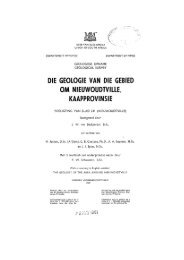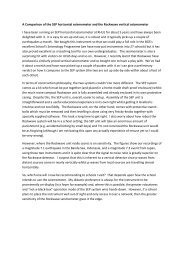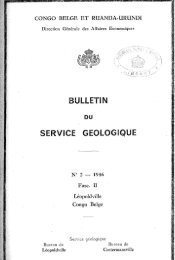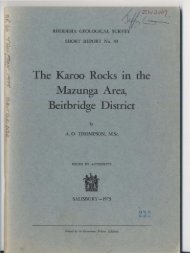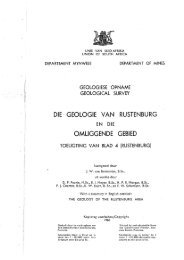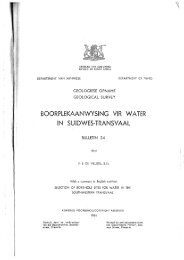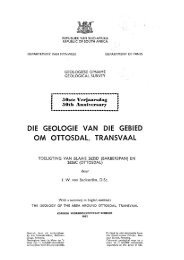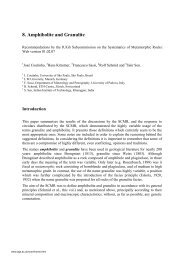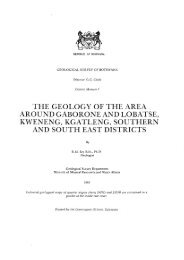Bibliography - British Geological Survey
Bibliography - British Geological Survey
Bibliography - British Geological Survey
Create successful ePaper yourself
Turn your PDF publications into a flip-book with our unique Google optimized e-Paper software.
Weidenreich, F. 1936. The mandibles of Sinanthropus pekinensis: a comparative study. Palaeontologia<br />
Sinica, Series D, 7 (3), 132 pp, 15 plates. (The Piltdown mandible, pp. 117–119. Considers the Piltdown jaw<br />
and skull to be unrelated: ‘If the Piltdown mandible is to be considered as belonging to a human being ... this<br />
would imply that in England a hominid lived with the brain case of recent man and an ape-like mandible, while<br />
in the Far East (Choukoutien) at about the same time another human being lived with the most primitive brain<br />
case known hitherto, approaching that of chimpanzee and with a mandible distinctly closer related to that of<br />
recent man than to chimpanzee.’ Detailed comparison shows that ‘The Piltdown jaw resembles at the most a<br />
female orang and is no more similar to Sinanthropus than the female orang.’)<br />
Weidenreich, F. 1937. The dentition of Sinanthropus pekinensis: a comparative odontography of the<br />
hominids. Palaeontologia Sinica, New Series D, no. 1, v, 180 pp + separate atlas of plates. (The Piltdown<br />
teeth, pp. 146–149, & figs 141, 147, 213, 216, 217, 317 & 342 in atlas [not seen]. The molars in the Piltdown<br />
jaw are considered to be comparable with those of a modern female orangutan, whereas the isolated molar<br />
from Piltdown II is thought to be more human. The Piltdown canine is quite unlike that of Sinanthropus, but<br />
neither does it bear any resemblance to that of an orang and thus does not belong with the jaw. Also, the<br />
smooth, concave wear on this tooth does not fit the pattern of wear expected of a canine.)<br />
Weidenreich, F. 1943. The skull of Sinanthropus pekinensis: a comparative study on a primitive hominid<br />
skull. Palaeontologica Sinica, New Series D, no. 10, whole series no. 127, xxi,298 pp. (In the light of the<br />
discovery of Sinanthropus the author feels compelled to reject the authenticity of Piltdown Man. He supports<br />
the view, put forward by Frassetto in 1927 and Friederichs in 1932, that the Piltdown jaw belongs to an<br />
orangutan, p. 216.)<br />
Weiner, J. S. 1952. Physical anthropology since 1935. In: A hundred years of anthropology / edited by T. K.<br />
Penniman. London: Duckworth. (Including a review of the Piltdown conundrum)<br />
Weiner, J. S. 1954a. [Remarks on the Piltdown molars and canine.] Proceedings of the <strong>Geological</strong> Society<br />
of London, no. 1504 (6 Jan), xvii‒xviii. (Report of presentation made at a meeting on 25 Nov 1953. Weiner<br />
was evidently preceded at the meeting by A. T. Marston, and in opposition to Marston’s conclusion that the<br />
Piltdown jaw and teeth are those of a fossil ape, went on to present evidence of artificial abrasion shown by<br />
the molars and canine. Marston’s famous outburst, in which he criticised the experts for using Dawson as a<br />
scapegoat in order to cover up their own ineptitude, was widely reported in the press but went unremarked in<br />
the Society’s Proceedings; see Anon. 1953d, 1953e, Turrittin 2004. Oakley also made a presentation.)<br />
Weiner, J. S. 1954b. [Comparison of the Piltdown molars and canine with those of a female orangutan<br />
experimentally ground and polished.] Proceedings of the <strong>Geological</strong> Society of London, no. 1514, cxvi.<br />
(Report of a presentation made at a meeting on 2 June 1954 demonstrating the results of new investigative<br />
techniques applied to the Piltdown assemblage.)<br />
Weiner, J. S. 1955a. Outline of the Piltdown problem. In: Further contributions to the solution of the<br />
Piltdown problem / J. S. Weiner et al. Bulletin of the <strong>British</strong> Museum (Natural History), Geology, 2 (6),<br />
229–233. (Smith Woodward was able to put forward a coherent and convincing case for the integrity of<br />
Eoanthropus dawsoni, which Weiner resolves into a close-knit set of eleven arguments all tending to favour<br />
Woodward’s interpretation. The absence of the chin (symphysial region) and articulating condyle from the<br />
lower jaw was crucial in disguising its fully ape-like character; while the flat wear on the artificially abraded<br />
molar teeth was distinctly un-ape-like. By 1950 every possible opinion of Piltdown Man’s status had been<br />
discussed. Once the hypothesis of a fake or hoax had been entertained it provided a compelling explanation<br />
of the circumstances of the finds and the sequence of discoveries. Weiner lists seven issues that were<br />
adequately explained by such a hypothesis, now fully confirmed by the latest series of scientific tests.)<br />
Weiner, J. S. [Feb] 1955b. The Piltdown forgery. London: Oxford University Press, xii, 214 pp., 8 plates,<br />
correction slip; 2nd impression, corrected, Aug 1955; re-issued 2003 (50th anniversary edition) with a new<br />
introduction and afterword by Chris Stringer. Oxford: Oxford University Press, xix, 212 pp., 8 plates. (This<br />
remains one of the most readable examinations of the Piltdown affair, written by the man who initiated the<br />
scientific re-examination of the Piltdown assemblage in 1953 and undertook the first detailed investigation<br />
of the background to the forgery. Dawson appears as the principal suspect, but Weiner stops short of outright<br />
accusation. He had originally planned to call his book The Piltdown Fantasy, but learned that Francis Vere<br />
was already working on a book of the same title in defence of Dawson. Weiner was thus obliged to complete<br />
his book somewhat hurriedly in order to avoid being pipped to the post by Vere and others. A less than<br />
complimentary review appears in Edmunds 1955b.)



